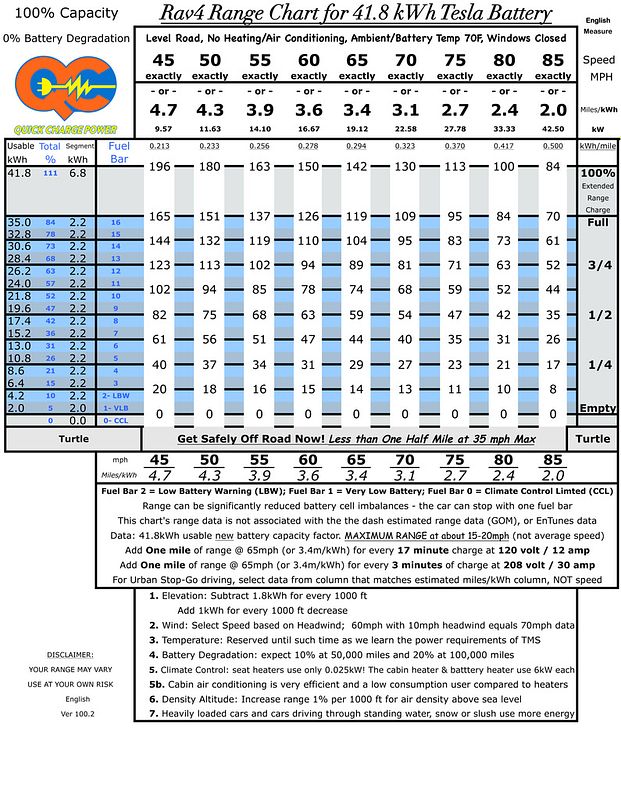GRA said:
JasonA said:
Charging a Rav4EV with CHAdeMO at $0.06/mile is currently an option and we do it. With NRG's pricing ($14.95/mo & .10/min) with the 50kwH ABB units, we get 1mile of range every 28 to 31sec (aka 2miles a min)
My average charge sessions are 20-30min max and equal 80 to 100miles of range. If my last bill was $32 and I went 540 miles on NRG alone..
Avg Charges/Mo 6
Avg Min/Charge 30
Per Month Fee 14.95
Per Minute Fee 0.10
Estimated Monthly Cost $32.95
540 NRG miles driven = 0.0610/mile
Now how is that bad??
P.S. I charge at home (have a very large solar array) but the Rav is used for long 150+ mile long trips and NRG is really kicking in now.
Terrific, now if NRG-eVgo were only installing QCs as a business instead of doing so in California as a result of a legal settlement with the state, we might be able to say that this model is financially viable over the long term. As it is, virtually all QCs here and around the country, and most public L2 FTM, are only here because of government subsidy. I don't know how close eVgo is to reaching the 200 QCs they are required to install in California, but I look forward to seeing if they continue to do so after reaching that total. And it would sure be helpful if they put one in my city within walking distance. Actually, I don't need QC for routine use, just affordable L2 as long as it's close enough. I suspect that unless the utilities are allowed to get directly involved in charging EVs, demand charges will kill any attempt to make public charging profitable.
However, I also expect that once autonomous vehicles demonstrate they have the required capability, safety and reliability, the need for many urban dwellers to own cars, already quite low in medium/high density cities with mixed-use zoning and good public transit including car-sharing, will dwindle to almost nothing, and most people will switch to purchasing mobility service. They might even make high quality public transit in sprawl viable and/or eliminate the need for it, or at least reduce the need for multiple cars per household. In the meantime, I continue using the current version of the ZEV technology I've owned continuously since I was 5 for my local transit needs, as it remains the cheapest, most energy- and space-efficient form of land transportation ever invented.
Sometime in this decade, Toyota will make a "big splash" about how they can drive their hydrogen car from LA to SF. There will be exactly one place to refuel, and one route to take to get to it. Hopefully, bridges washing out, traffic jams, plant failure, etc, won't happen that day, because it's a LOOOOooooong tow truck ride back to LA.
I drove Toyota's former compliance vehicle, the Rav4 EV, from San Diego (140 miles south of LA) to north of San Francisco in April 2015. 600 miles in one day. I used a multitude of public charging (including NRG / eVgo) and any one of more failures of equipment (it happened) didn't need a tow truck. There was always a plan B. No, my car was not equipped the way Toyota specified, since I have added DC quick charge capability. The fact that openly hostile companies towards EVs would intentionally hamper the ability to quickly recharge their minimum effort CARB-ZEV compliance EV cars speaks volumes.
Total refueling cost for that trip? Less than the cost of two KGs of hydrogen (about 50-100 miles worth of hydrogen). My brother just did a round trip, 2700 miles, in his Rav4 EV. His TOTAL refueling costs for the entire trip were about the cost of two KGs of hydrogen. That's from Washington state to San Diego and return. He covered about 500 miles per day.
With my new Tesla Model S-70D, all the refueling costs are prepaid, and quickly growing. Coast to coast in the US, and all over China, Japan, Europe with sprinklings elsewhere. That fantastic prepaid network will trickle down to the much lower cost Model 3.
Again, how does that awesome-O hydrogen compare in 2020? There's not even PLANS to put hydrogen in places that there are Tesla Superchargers. What decade does a hydrogen peddling operation start in my home state of Montana? (I'm betting not in my lifetime, and probably never... unless the feds demand and pay for it). There are several Superchargers, and I can drive across the state of Montana with nothing but my car, my sack lunch, and a smile.
I won't even mention my solar PV on the roof, making electric power to power my electric cars for pennies per mile (oh, there I go... I just did it).
I get the situation with folks who don't have home or work charging opportunities, and the lure of a hydrogen as a quick fix. But, charging WILL GET FASTER, and even those situations where public charging is the only option, it will be possible to charge up much like you would gas up.
I think I may get a new bike, but it will have electric boost for the hills. Might keep it in the back of the EV for those infrequent public charging events that hydrogen folks don't have to worry about... at least the infrequent part. If you love refueling your oil car, you're gunna love hydrogen.
My weekend trip, 30 April 2015 until 3 May 2015, from San Diego to Santa Rosa, and return:
The capabilities of the 2012-2014 Toyota Rav4 EV compliance car:





